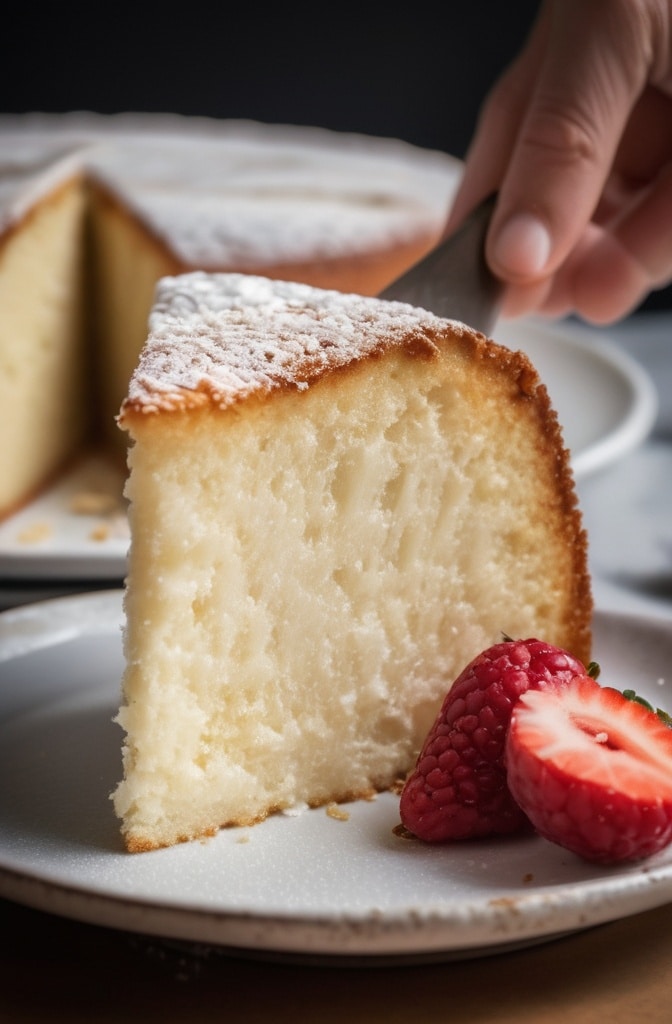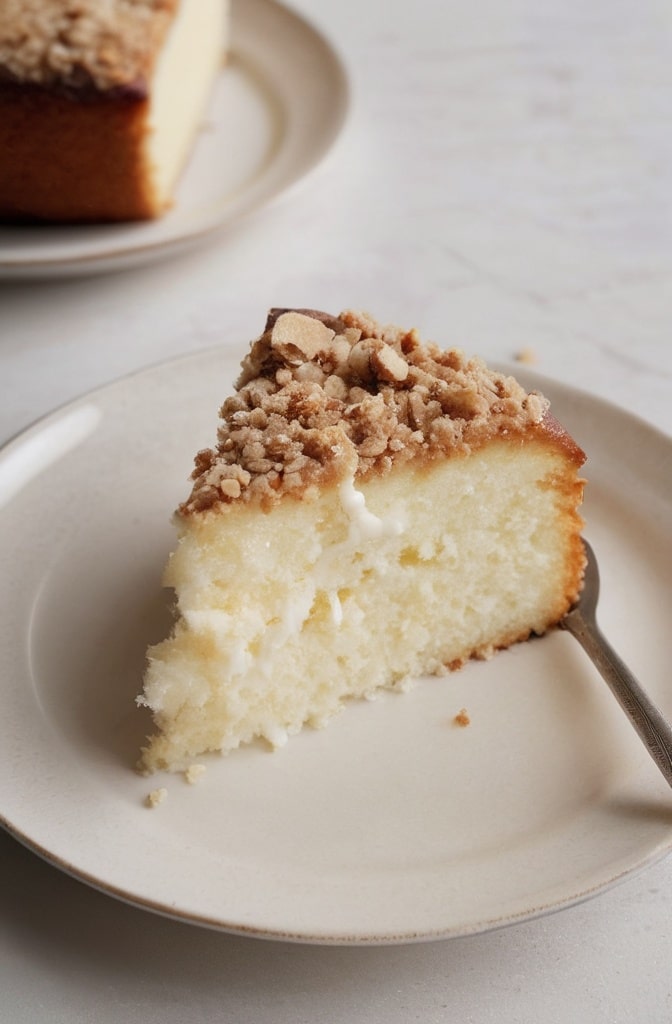I still remember the first time I tasted a proper Fluffy Yogurt Cake. The summer breeze wafted through my grandmother’s kitchen window as she pulled out what looked like a pillowy dream from her ancient oven. “This,” she whispered, “is what happens when science meets patience.” That moment forever changed my understanding of what a dessert could be.
Have you ever bitten into something so light it almost disappears on your tongue, yet leaves behind the most satisfying tangy-sweet memory? That’s the magic of a perfect yogurt cloud cake. It’s not just another dessert—it’s an experience that balances the richness of traditional cakes with the airy lightness that makes you feel like your eating actual clouds.
This recipe elevates the humble yogurt into a showstopping centerpiece that will have your guests begging for the recipe. The science behind it is fasinating—the protein structures in yogurt combined with whipped egg whites create a texture that’s impossibly light while maintaining structural integrity.
Ingredients & Substitutions
For the Cake Base:
- 2 cups Greek yogurt (full-fat provides best results, but 2% works decently)
- 6 large eggs, separated (room temperature is crucial)
- 1 cup granulated sugar, divided
- 2 teaspoons pure vanilla extract
- Zest of 1 lemon (organic preferred)
- 1/4 cup fresh lemon juice
- 1/4 cup all-purpose flour
- 3 tablespoons cornstarch
- 1/2 teaspoon cream of tartar
- Pinch of salt
For the Yogurt Cream Layer:
- 1 1/2 cups Greek yogurt
- 1/2 cup powdered sugar, sifted
- 1 teaspoon vanilla bean paste (or extract)
- 1 tablespoon unflavored gelatin
- 3 tablespoons cold water
- 1 cup heavy cream, whipped to soft peaks
For the Fruit Topping:
- 2 cups mixed seasonal berries (strawberries, blueberries, raspberries)
- 2 tablespoons honey or maple syrup
- 1 tablespoon fresh lemon juice
- Fresh mint leaves for garnish
The yogurt selection is actually critical here—Turkish or Greek styles work best due to their higher protein content and thicker consistency. If you need to go dairy-free, coconut yogurt makes a surprisingly excellent substitution, tho the texture will be slightly different. The tanginess won’t be quite the same, but the richness compensates.
For those watching sugar intake, monk fruit sweetener or erythritol can replace granulated sugar at a 1:1 ratio, with minimal impact on the final texture. Just avoid liquid sweeteners as they’ll throw off the moisture balance.
Step-by-Step Instructions

Preparing the Cake Base:
- Preheat your oven to 325°F (163°C). Line the bottom of a 9-inch springform pan with parchment paper and lightly grease the sides. Wrap the outside of the pan with aluminum foil to prevent any water from seeping in during baking. Pro tip: Double-wrapping with heavy-duty foil prevents water infiltration better than single-wrapping with regular foil. Nothing ruins a cloud cake faster than soggy bottum.
- Separate eggs carefully, ensuring absolutely no yolk contaminates the whites. Even a tiny bit of yolk can prevent proper whipping. Set both aside to reach room temperature—cold eggs don’t whip to maximum volume. Common mistake: People often underestimate how important temperature is here. Take the eggs out at least 30 minutes before you start baking.
- Whisk together flour, cornstarch, and salt in a small bowl. This pre-mixing ensures even distribution of dry ingredients without overworking the batter later.
- In a large bowl, beat egg yolks with 1/2 cup sugar until pale and thickened—about 3-4 minutes with an electric mixer. The mixture should fall in ribbons when you lift the beaters. Expert insight: This step is called “ribboning” and creates a critical air structure that contributes to the cake’s final texture.
- Gently fold in yogurt, vanilla extract, lemon zest, and lemon juice until just combined. Overmixing here will deflate your carefully incorporated air.
- Sift the flour mixture over the yogurt mixture and fold in with a spatula using a gentle cutting motion. Think of it as sliding the spatula down the middle and around the sides in a continuous motion.
- In a separate, absolutely clean bowl (any residual fat will prevent proper whipping), beat egg whites until foamy. Add cream of tartar, then gradually add remaining 1/2 cup sugar while beating until stiff, glossy peaks form. Science note: Cream of tartar is an acid that stabilizes egg white proteins, allowing for better structure retention during baking.
- Fold one-third of the egg whites into the yogurt mixture to lighten it, then gently fold in remaining whites in two batches. Your goal is maximum incorporation with minimum deflation.
- Pour the batter into the prepared pan and smooth the top. Place the springform pan in a larger roasting pan and add hot water to come halfway up the sides of the springform. Why this works: This water bath (bain-marie) ensures even, gentle heat distribution, which prevents the cake from cracking and promotes that characteristic cloud-like texture.
- Bake for 45-50 minutes until the center is just set but still slightly jiggly. The cake will continue cooking from residual heat after removal.
- Turn off oven, crack the door open, and let the cake cool in the oven for 1 hour. This gradual temperature change prevents sudden collapse.
- Remove from water bath, run a thin knife around the edge, and chill for at least 4 hours or overnight.
Preparing the Yogurt Cream Layer:
- In a small bowl, sprinkle gelatin over cold water and let stand for 5 minutes to bloom. The granules should fully absorb the water and look swollen.
- Microwave the bloomed gelatin for 10-15 seconds until just melted, or place the bowl in hot water to dissolve. Allow to cool slightly but not set.
- In a medium bowl, whisk together yogurt, powdered sugar, and vanilla bean paste until smooth and well-combined. Flavor enhancement: Scraping a real vanilla bean adds visible specks and significantly more complex flavor than extract alone.
- Slowly whisk the melted gelatin into the yogurt mixture, ensuring no lumps form. You’re aiming for complete incorporation without overworking.
- Gently fold in the whipped cream using a large spatula, maintaining as much air as possible. The final texture should be light but stable.
- Spread this mixture evenly over the chilled cake base and return to refrigerator for at least 2 hours until set. For variation: Add 2 tablespoons of limoncello or Grand Marnier to the cream layer for an adult version with subtle complexity.
Preparing the Fruit Topping:
- In a medium bowl, gently toss berries with honey and lemon juice. Let macerate for 15-20 minutes—this draws out juices and intensifies flavors.
- Just before serving, arrange the macerated berries over the top of the cake in an attractive pattern. The contrast between the white cake and vibrant fruit is part of the visual appeal.
- Garnish with fresh mint leaves for a color contrast and subtle aromatic element.
Cooking Techniques & Science
The yogurt cloud cake represents a beautiful intersection of chemistry and culinary art. The protein structures in both the yogurt and eggs form the foundation of this dessert’s unique texture. Unlike traditional cakes that rely heavily on gluten development, this cake achieves its structure through protein coagulation.
When yogurt is heated, its proteins denature and form new bonds, creating a semi-solid matrix that’s both stable and tender. The acidity in yogurt also activates the leavening properties in the eggs, further enhancing the rise. This is why using full-fat Greek yogurt yields superior results—the higher protein content creates better structure while the fat contributes to mouthfeel

The careful separation and subsequent folding of egg whites introduces a controlled amount of air pockets. As these air bubbles heat during baking, they expand, while simultaneously the proteins set around them, creating a permanent structure of tiny air cells. That’s where the “cloud” in cloud cake comes from.
The water bath technique is not just traditional nonsense—it serves an important purpose. By surrounding the cake with water, which cannot exceed 212°F (100°C), you ensure the outer edges don’t cook too quickly. This prevents the common issue of a rubbery exterior and undercooked interior that plagues many yogurt-based cakes.
One essential tool for this recipe is a proper springform pan with a tight seal. Leakage during the water bath stage can be disasterous. If you’re uncertain about your pan’s seal, a slow cooker liner wrapped around the outside provides excellent insurance against water infiltration.
Serving & Pairing Suggestions
This yogurt cloud cake presents beautifully when served on a pedestal cake stand, which showcases its layers and allows guests to appreciate its textural complexity. Slice with a hot, clean knife for the cleanest presentation—wipe the blade between each cut.
For individual servings, consider adding a small pool of berry coulis on the plate first, then position the cake slice in the center, with a few fresh berries and a mint sprig for garnish. The vibrant red against the cloud-white cake creates an irresistible visual contrast.
This dessert pairs surprisingly well with both sweet and dry wines. A late-harvest Riesling complements the tangy notes, while a glass of Prosecco offers a palate-cleansing effervescence between bites. For non-alcoholic options, a lightly sweetened matcha tea provides an interesting counterpoint to the cake’s flavor profile.
The cake also works beautifully alongside other desserts in a tasting menu. Consider serving smaller portions with a chocolate-based dessert and something nutty to create a well-rounded dessert experience with contrasting textures and flavors.
For a more casual presentation, transform this recipe into individual parfaits by layering crumbled cake base with the yogurt cream and fresh berries in clear glasses. This makes for an elegant brunch option that can be prepared up to 12 hours in advance.
Conclusion
The yogurt cloud cake represents the perfect balance between technical skill and simple ingredients. What makes this recipe truly special is the transformation of everyday yogurt into something ethereal through careful technique.
Remember that patience is perhaps the most important ingredient—rushing the cooling or setting stages will compromise the delicate texture that defines this dessert. When done correctly, you’re rewarded with a dessert that feels simultaneously indulgent and light, rich and refreshing.
For troubleshooting, keep in mind that most failures stem from either egg white deflation or water infiltration during baking. Take your time with the folding technique, and ensure your springform pan is properly wrapped.
Consider this recipe a jumping-off point for seasonal variations. In summer, stone fruits like peaches work beautifully in place of berries. In fall, poached pears and a hint of cinnamon transform the character entirely. Winter calls for blood oranges and a touch of rosemary-infused honey. The base technique remains the same, but the personality of the cake can evolve with your culinary imagination and the seasons.
FAQs About Fluffy Yogurt Cake
Can I make this cake ahead of time?
Absolutely! This yogurt cloud cake actually benefits from an overnight rest in the refrigerator. The flavors meld and the texture sets perfectly. You can prepare everything except the fresh fruit topping up to 2 days in advance. Add the fruit just before serving to prevent any bleeding of colors or softening of the top layer.
Why did my cake sink in the middle?
The most common reason for sinking is premature removal from the oven or sudden temperature changes. The gradual cooling in the turned-off oven is essential for maintaining structure. Also check that your egg whites reached proper stiff peaks—underwhipped whites provide insufficient structure.
Can I freeze this cake?
While possible, freezing isn’t ideal for this particular dessert. The high moisture content in the yogurt can form ice crystals that disrupt the delicate texture upon thawing. If you must freeze it, do so without the fruit topping and thaw overnight in the refrigerator for best results.
My yogurt cream layer didn’t set properly. What went wrong?
This typically happens when the gelatin wasn’t properly bloomed or was overheated, destroying its setting properties. Make sure the gelatin fully absorbs water before heating, and never let it boil. Another possibility is that the cream was overwhipped before folding, breaking the fat structure.
How do I prevent a soggy bottom when using the water bath?
Double-wrapping your springform pan with heavy-duty aluminum foil is crucial. For extra insurance, place the foil-wrapped pan inside a slow cooker liner or oven bag before placing in the water bath. Some bakers also use a silicone wrap specially designed for springform pans, which provides an excellent water barrier.

